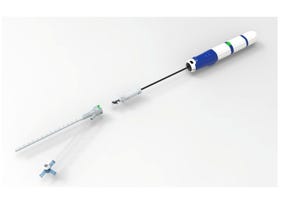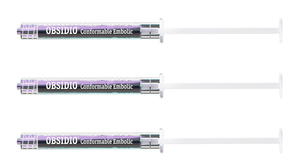September 4, 2002
Originally Published MPMN September 2002
PRODUCT UPDATE
Advances in Adhesive Products
Epoxies and equipment offer increased functionality
Adhesives are an integrated part of many medical devices. Transcending their traditional role of simply holding components in place, however, these products now offer manufacturers sterilizability, chemical resistance, electrical insulation characteristics, and a range of other properties that can increase device functionality. But with what seems like an almost unlimited number of different epoxy formulations on the market, it can be difficult to determine which one will work best with a specific product.To help alleviate this dilemma, this article examines several recent advances in adhesives and related equipment. The accompanying Buyers Guide grid beginning on page 60 provides a comprehensive list of these and other companies that supply such products.
Semirigid epoxy accommodates varying rates of thermal expansion
|
Supplied by Master Bond Inc., an epoxy allows the bonding of components with different rates of thermal expansion. |
Suited for the assembly of disposable and reusable devices, a two-component epoxy resin system from Master Bond Inc. cures semirigidly to allow the bonding of elements with different rates of thermal expansion. "Many devices are required to undergo thermal cycling, something that can put stress on the components used to hold them together," explains vice president of technical support Robert Michaels. "Our EP21LV adhesive cures with a combination of flexible and rigid properties to eliminate this concern. It isn't rubbery like silicone, but it has some give, and simultaneously offers toughness and durability," he says. Providing bond strengths of 500 to 5000 psi, the epoxy is compatible with most metal, plastic, glass, ceramic, and rubber substrates.
Certified to USP Class VI specifications, EP21LV epoxy does not contain solvents or other volatile ingredients. Applied by manual or semi- or fully automated methods, the material offers limited sterilization capabilities. "Under most conditions, it will withstand three to five sterilizations by gamma, EtO, chemical, or autoclave methods, though in certain situations it could last for up to 10 cycles," says Michaels. According to Master Bond, the epoxy cures readily at ambient temperatures, or more quickly when heat is applied. When fully cured, the polymer offers resistance to vibration, impact, thermal shock, and chemicals. Acceptable operating temperatures span –80° to 250°F.
The EP21LV adhesive is suited for bonding, sealing, and casting applications. Commonly used with endoscopes and diagnostic equipment, the material can also be used for potting and encapsulation. Because it withstands brief exposure to harsh acids and bases, and offers electrical insulation properties, the epoxy is compatible with adverse environmental conditions.
Low-fluorescence adhesive enhances signal detection
Developed by Adhesives Research Inc., an adhesive system exhibits low autofluorescence to enhance signal detection in molecular technology applications. Used for bonding cover films to biological assays, the pressure-sensitive adhesive reduces the risk of undesirable background interference. "The precise evaluation of fluorescence levels is essential for analyzing biomolecules, drug discovery, DNA sequencing, and a range of other applications," says director of marketing William Meathrel. "This adhesive ensures that researchers will be able to perform these tasks without worrying that background fluorescence is affecting sensitivity."
Other beneficial properties of the adhesive include dimensional stability and the ability to withstand temperature and moisture changes. According to company sources, the material does not flow into microfluidic channels, and adheres to surfaces without creating voids or gaps that would allow the migration of assay components. Available in flexible or rigid formulations, the clear adhesive is resistant to chemical reagents and offers compatibility with electrophoretic and other means of separation.
Potential applications for the adhesive include multiwell platforms, microarrays, microfluidic devices, and biocards. To ensure a good fit with an application, the company can modify the adhesive to offer hydrophilicity and other properties.
Dispense valve minimizes dead space to increase deposit control
A needle valve is constructed with a minimum of dead space to allow the application of adhesives in deposits as small as 0.007 in. in diameter. Unlike traditional products, the 741 MD-SS MicroDot valve from EFD Inc. features an internal needle that is seated in the hub of the dispensing tip rather than the valve body. "This construction eliminates the need for a tip adapter, minimizing dead space to within the cannula itself," says technical director Bob Tourigny. "As a result, the MicroDot valve gives manufacturers the ability to set deposit amounts very precisely and maintain that volume over time."
Another feature of the valve is a two-ring calibration knob that eases the task of needle replacement. "When changing needles, the important thing for consistency is to maintain the same stroke and tip-to-substrate distance, tasks that are complicated by the inevitable tolerance variations between components," says Tourigny. "Our valve makes it easy to restore the same settings by simply turning the knob until you're back where you need to be." Tourigny estimates that the calibration knob shortens needle replacement time to 30 seconds from 4 to 5 minutes.
The compact, pneumatically operated valve is compatible with most assembly fluids, including UV-cured adhesives, solvents, lubricants, and adhesives. The product can be used with automated equipment, robots, x-y-z machinery, and workbench or stand-mounted dispensing stations. Common medical applications include the assembly of disposable plastic products, microelectronics, and fiber-optic devices. Typically, the component is used in conjunction with the company's Valvemate 7000 controller, which allows the adjustment of dispense times in increments of 1/1000th of a second.
UV-cured adhesives feature USP Class VI certification
|
A UV-cured adhesive from Tangent Industries Inc. is free of solvents and nontoxic when fully cured. |
Available in a variety of formulations, UV-cured acrylate adhesives from Tangent Industries Inc. are certified to USP Class VI and ISO 10933 specifications. Capable of bonding glass, stainless steel, and polycarbonate and other plastics, the Vitralit series of adhesives are free of solvents and nontoxic when fully cured. Suited for filling cracks and encapsulation, the materials cure readily when exposed to UV light. "Typical curing times range from 1 to 2 seconds to a couple of minutes, depending on the nature of the assembly and the thickness of the adhesive," says vice president Richard Wick.
Compatible with manual to fully automated application processes, the Vitralit adhesives withstand limited gamma, EtO, and vapor sterilization. Common product uses span the bonding of anesthesia masks, blood pressure transducers, blood oxygenators, stopcocks, fittings, adapters, and arterial filters. Other applications include the joining of stainless-steel cannulae to flexible PVC infusion lines or transparent or translucent hubs and syringes. Though the product line includes a number of formulations, the company will custom design an adhesive to suit individual specifications upon request.
Copyright ©2002 Medical Product Manufacturing News
You May Also Like




